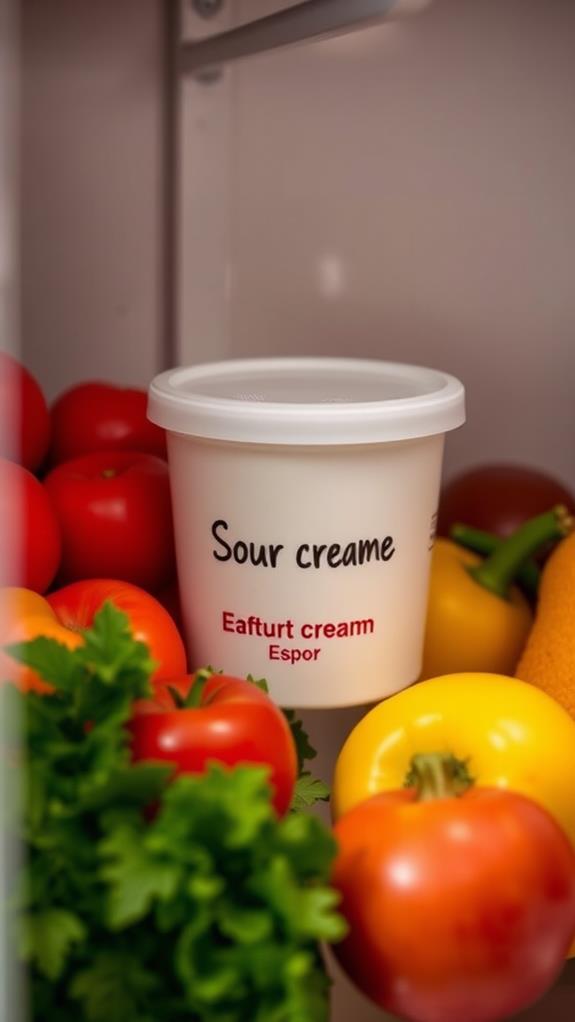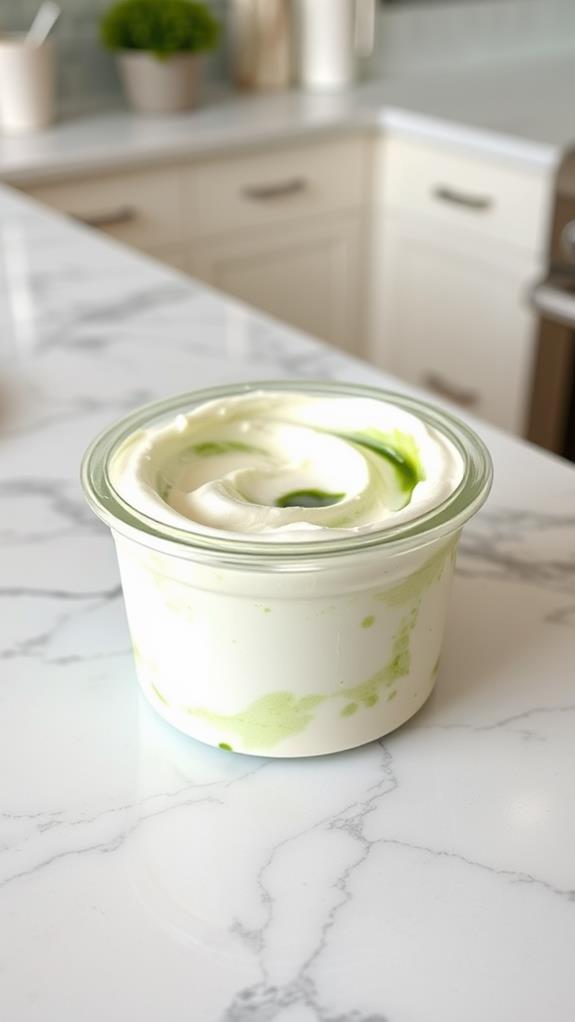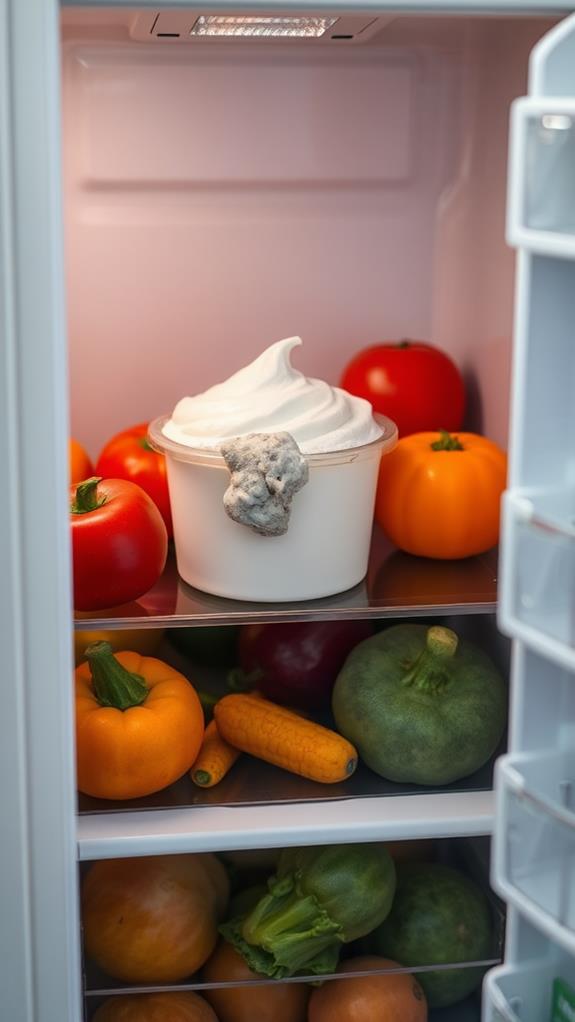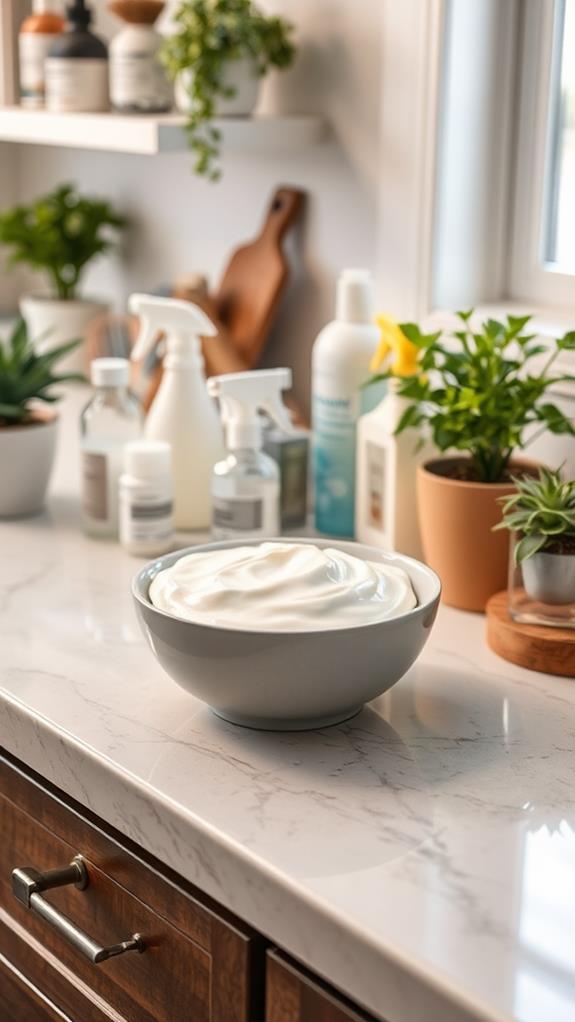Is Expired Sour Cream Safe to Eat
Expired sour cream isn't always unsafe to eat, but you'll need to use your senses and judgment to determine its edibility. The expiration date on the container is more of a quality indicator than a strict safety cutoff. If stored properly at or below 40°F (4°C), sour cream can often last 1-2 weeks beyond its printed date. Look for signs of spoilage like mold, unusual odors, or changes in texture and color. While consuming slightly expired sour cream may not pose significant risks, it's essential to be cautious, as foodborne illnesses can occur. When in doubt, it's best to discard the product. Understanding proper storage techniques and alternative uses can help you make the most of your sour cream.
This post may contain affiliate links. If you make a purchase through these links, I may earn a commission at no additional cost to you. Additionally, portions of this post may be generated using artificial intelligence (AI) technology. While we strive for accuracy, please be aware that AI-generated content may not always be perfect and should be fact-checked when necessary.
The Spatula Scoops
- Expired sour cream can be safe to eat if properly stored and showing no signs of spoilage.
- Sour cream often lasts 1-2 weeks beyond its printed date when refrigerated at or below 40°F (4°C).
- Signs of spoiled sour cream include mold, unusual odors, discoloration, and changes in texture.
- Consuming spoiled sour cream can lead to foodborne illnesses from bacteria like Listeria or Salmonella.
- When in doubt about the safety of expired sour cream, it's best to discard it to avoid health risks.
Understanding Sour Cream Expiration Dates

When it comes to understanding sour cream expiration dates, it's crucial to know what they really mean. These dates aren't hard-and-fast rules but rather guidelines for prime quality. You'll typically find two types of dates on your sour cream container: a "sell-by" date and a "best-by" date. The sell-by date is for retailers, indicating when they should remove the product from shelves. The best-by date, however, is more relevant to you as a consumer. Similar to oatmeal expiration dates, these dates can be misleading and don't necessarily indicate safety.
This best-by date suggests when the sour cream will be at its peak quality, but it doesn't necessarily mean the product is unsafe to consume after this date. Sour cream can often last 1-2 weeks beyond its printed date if properly stored. To maximize shelf life, keep your sour cream refrigerated at or below 40°F (4°C) and always use clean utensils when scooping it out. Look for signs of spoilage such as mold, off-odors, or significant texture changes. If you notice any of these, it's best to discard the sour cream. Remember, proper storage and handling are key factors in determining how long your sour cream remains safe to eat.
Factors Affecting Sour Cream Shelf Life
The longevity of sour cream depends on several key factors. Understanding these elements can help you maximize its shelf life and ensure you're consuming it safely. Here's a breakdown of the main factors affecting sour cream's lifespan:
| Factor | Impact |
|---|---|
| Temperature | Higher temperatures accelerate spoilage |
| Packaging | Airtight containers slow bacterial growth |
| Contamination | Introducing foreign substances reduces shelf life |
| Preservatives | Added ingredients extend usability |
Storage temperature plays a pivotal role. You'll want to keep your sour cream refrigerated at or below 40°F (4°C) to slow bacterial growth. The packaging also matters; unopened, factory-sealed containers will last longer than those you've already opened. Once you've broken the seal, it's crucial to reseal the container tightly after each use.
Contamination is another significant factor. Every time you dip a spoon into the container, you're potentially introducing new bacteria. Using clean utensils and avoiding double-dipping can help preserve your sour cream's freshness. Ultimately, some brands include preservatives that can extend the product's shelf life, but these additives may affect taste and texture.
Signs of Spoiled Sour Cream

Despite its tangy nature, sour cream can indeed spoil. To determine if your sour cream has gone bad, you'll need to use your senses. First, look for visible signs of spoilage. If you notice any mold growth, particularly green or black spots, it's time to discard the product. Next, pay attention to the texture. Fresh sour cream should be smooth and creamy. If it's become lumpy, watery, or separated, it's likely past its prime. These signs are similar to those of spoiled tofu, which also exhibits textural changes and discoloration when it goes bad.
The smell test is another reliable indicator. While sour cream naturally has a tangy aroma, spoiled sour cream will have an off-putting, rancid odor. If you detect any unusual or unpleasant smells, it's best to err on the side of caution and throw it out.
Here are additional signs that your sour cream may have spoiled:
- A yellowish or pinkish discoloration on the surface
- A slimy or excessively watery consistency
- An unusually sour or bitter taste
Proper Storage Techniques
Proper storage plays a key role in maintaining sour cream's quality and safety. To maximize its shelf life, you'll want to keep your sour cream refrigerated at or below 40°F (4°C). Always use clean utensils when scooping out sour cream to prevent contamination, and make sure to seal the container tightly after each use. This helps minimize exposure to air and bacteria, which can accelerate spoilage. For those who frequently consume pickles or other jarred foods, consider using an airtight glass jar with a strainer for easy access and to sustain freshness.
For prime freshness, store sour cream in its original container on a refrigerator shelf rather than in the door. The door's temperature fluctuates more due to frequent opening, potentially compromising the product's quality. If you've opened a large container and don't plan to use it all quickly, consider transferring smaller portions to airtight containers. This practice reduces air exposure and cross-contamination risks.
When freezing sour cream, be aware that its texture may change upon thawing. While it's safe to consume, it might become grainy or separated. To mitigate this, stir the thawed sour cream thoroughly before use. For best results, use frozen sour cream within two to four months. Remember, proper storage techniques can greatly extend your sour cream's usability and guarantee food safety.
Risks of Consuming Expired Sour Cream

Consuming expired sour cream can pose several health risks you should be aware of. When sour cream goes bad, it can harbor harmful bacteria that cause foodborne illnesses. These bacteria multiply rapidly in dairy products, especially when they're past their expiration date. You might experience symptoms like nausea, vomiting, diarrhea, or stomach cramps if you consume spoiled sour cream.
The risks of eating expired sour cream include:
- Food poisoning from bacteria like Listeria or Salmonella
- Exposure to toxins produced by mold growth
- Potential allergic reactions due to altered protein structures
Even if the sour cream doesn't show visible signs of spoilage, it can still be unsafe to eat. The acidity in sour cream can mask the growth of some harmful bacteria, making it difficult to detect by smell or taste alone. It's essential to pay attention to expiration dates and storage conditions to minimize these risks. While some dairy products might be safe to consume shortly after their expiration date if properly stored, it's always best to err on the side of caution when it comes to sour cream.
Extended Use Beyond Expiration Date
When it comes to using sour cream beyond its expiration date, storage conditions play an essential role in its safety and quality. You'll want to keep your sour cream refrigerated at or below 40°F (4°C) to slow bacterial growth and maintain freshness. Before consuming expired sour cream, always check for signs of spoilage such as mold, off-odors, or unusual discoloration, which indicate it's no longer safe to eat.
Storage Conditions Matter
Storage conditions play an essential role in determining whether expired sour cream is safe to eat. Proper refrigeration is vital for maintaining its quality and safety beyond the expiration date. You'll want to keep your sour cream at a consistent temperature below 40°F (4°C) to slow bacterial growth. Remember, every time you open the container, you're introducing new bacteria, so handle it carefully.
The way you store sour cream can tremendously impact its shelf life:
- Always use clean utensils to scoop out the product
- Keep the lid tightly sealed when not in use
- Store it in the main body of the refrigerator, not the door
If you've left sour cream out at room temperature for more than two hours, it's best to discard it. Bacterial growth accelerates in the "danger zone" between 40°F and 140°F (4°C to 60°C). Even if it looks and smells fine, harmful bacteria might have multiplied to unsafe levels. When in doubt, it's always better to err on the side of caution and throw it out.
Signs of Spoilage
Your senses are your best tools for detecting spoilage in sour cream, even if it's past its expiration date. Look for visible signs of mold, which can appear as fuzzy spots in various colors like green, blue, or black. If you notice any discoloration or an unusual texture, it's best to discard the sour cream.
The smell test is essential. Fresh sour cream has a tangy, slightly acidic aroma. If you detect any off-odors, such as a rotten or putrid smell, it's a clear indication that the sour cream has gone bad. Additionally, pay attention to the taste. While you shouldn't consume large amounts of questionable sour cream, a small taste can reveal if it's spoiled. If it tastes overly sour, bitter, or unpleasant, don't use it.
Check the consistency as well. Fresh sour cream should be smooth and creamy. If you notice any separation, excessive wateriness, or a lumpy texture, it's likely past its prime. Remember, these signs of spoilage can occur before or after the expiration date, depending on storage conditions and handling. Trust your senses and err on the side of caution to avoid foodborne illness.
Alternative Uses for Old Sour Cream

If you're wondering what to do with sour cream that's past its prime, you've got options beyond tossing it out. You can use slightly expired sour cream in baked goods or heated dishes, where any slight changes in taste or texture won't be noticeable. For non-food applications, consider using old sour cream as a face mask or to polish copper, while severely spoiled sour cream can be added to your compost bin to enrich your garden soil.
Cooking With Expired Sour Cream
While consuming expired sour cream raw isn't recommended, you can still put it to good use in your cooking. Expired sour cream can be incorporated into various baked goods, adding moisture and tangy flavor to your recipes. You'll find it works well in cakes, muffins, and quick breads, where the baking process eliminates potential harmful bacteria.
When using expired sour cream in cooking, consider these options:
- Mix it into batters for pancakes or waffles
- Use it as a substitute for milk or buttermilk in baking recipes
- Incorporate it into savory dishes like casseroles or creamy sauces
Remember to use your senses when determining if the sour cream is still suitable for cooking. If it smells off, has visible mold, or has separated considerably, it's best to discard it. When in doubt, err on the side of caution and use fresh ingredients.
Non-Food Uses
Expired sour cream doesn't have to go to waste, even if it's no longer suitable for eating. You can repurpose it for various non-food applications around your home. One practical use is as a natural face mask. The lactic acid in sour cream can help exfoliate and moisturize your skin. Simply apply a thin layer to your face, leave it on for 15 minutes, then rinse off with warm water.
In the garden, sour cream can serve as a fertilizer. Its acidic nature and nutrient content can benefit certain plants. Mix it with water and apply it to the soil around acid-loving plants like azaleas or rhododendrons. You can also use it as a polish for leather items. The fats in sour cream can help condition and restore shine to leather shoes, bags, or furniture.
For arts and crafts projects, expired sour cream can be used as a binding agent in homemade clay or as a base for textured paint. When mixed with food coloring, it creates a unique, creamy paint that's perfect for finger painting or other creative activities with children.
Composting Old Sour Cream
Composting offers an eco-friendly way to dispose of old sour cream. When you're faced with expired sour cream, don't just toss it in the trash. Instead, consider adding it to your compost pile. The dairy product's organic content can enrich your compost, providing valuable nutrients for your garden.
To compost old sour cream effectively, follow these guidelines:
- Mix it with carbon-rich materials like dry leaves or shredded paper
- Bury it deep in the compost pile to avoid attracting pests
- Use small amounts to maintain the proper balance of your compost
When to Discard Sour Cream
Although sour cream can last beyond its printed date when properly stored, there are clear signs that indicate it's time to discard it. You'll want to look for visible mold growth, which can appear as fuzzy spots in various colors like green, blue, or black. If you notice any unusual discoloration or a change in texture, such as separation or excessive watery liquid, it's best to err on the side of caution and throw it out.
Another key indicator is the smell. While sour cream naturally has a tangy aroma, if you detect any off-putting or rancid odors, it's time to say goodbye. Trust your nose; it's often your best tool for determining freshness. Additionally, if the sour cream has been left at room temperature for more than two hours, it's no longer safe to consume due to potential bacterial growth.
Frequently Asked Questions
Can Expired Sour Cream Be Used in Baking?
While it's possible to use expired sour cream in baking, you should exercise caution. The acidity and bacterial content of sour cream can change over time, potentially affecting your recipe's outcome. If the sour cream has only recently expired and shows no signs of mold or off-odors, you might be able to utilize it. However, for the best results and to guarantee food safety, it's always recommended to use fresh ingredients in your baking projects.
How Long Does Homemade Sour Cream Last Compared to Store-Bought?
You might think your homemade sour cream is a champion of longevity, but don't get too cocky. Homemade sour cream typically lasts 1-2 weeks when refrigerated properly, while store-bought versions can survive 3-4 weeks past their printed date. The difference lies in preservatives and processing methods used commercially. Your DIY dairy delight lacks these shelf-life enhancers, so it's more prone to spoilage. Always check for signs of mold, off-odors, or unusual textures before consuming, regardless of the source.
Is It Safe to Freeze Sour Cream to Extend Its Shelf Life?
You can freeze sour cream to extend its shelf life, but it is crucial to recognize that the texture may change. When thawed, it can become grainy or separated. To freeze, transfer the sour cream to an airtight container, leaving some space for expansion. It'll last up to six months in the freezer. When you're ready to use it, thaw it in the refrigerator and stir well to recombine. It's best used in cooked dishes rather than as a topping after freezing.
Can Sour Cream Cause Food Poisoning Even if It's Not Expired?
Yes, sour cream can cause food poisoning even if it's not expired. While expiration dates are helpful, they're not foolproof. Bacteria like Listeria and Salmonella can grow in sour cream if it's been improperly stored or contaminated. You should always check for signs of spoilage, such as an off smell, mold, or unusual texture. Even if it looks fine, if you're unsure about its safety, it's best to err on the side of caution and discard it.
Are There Any Health Benefits to Consuming Cultured Sour Cream Past Its Date?
Picture a spoonful of creamy, tangy goodness. You might be tempted to consume cultured sour cream past its date, but there aren't any proven health benefits. In fact, it's risky. While the live cultures in sour cream can offer probiotic benefits when fresh, they don't improve with age. As sour cream ages, harmful bacteria may grow, potentially causing foodborne illness. It's best to stick to fresh sour cream within its expiration date for both safety and ideal nutritional value.
Conclusion
When it comes to sour cream, you're walking a fine line between caution and waste. While expiration dates aren't set in stone, they're your compass in the murky waters of food safety. Trust your senses, but don't gamble with your health. Remember, proper storage is your ally in extending shelf life. When in doubt, it's better to toss it out. Your digestive system will thank you for erring on the side of caution, even if your taste buds protest.





